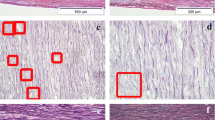Abstract
Specific sites of atherosclerotic processes due to hemodynamic changes and resultant stress, including how these normal anatomical structures become problematic in certain individuals, have yet to be acknowledged. One of these areas of the cardiovascular system occurs at the sinutubular junction (SJ), causing altercation in an otherwise normal flow status. The anatomy of the SJ was examined in 100 adult human hearts during the gross anatomy course at St George’s University, during the years 2006–2007. All hearts were examined in situ, using a General Electric model 3200S ultrasound machine with a 5 MHz linear probe. The aforementioned cadavers were also examined using a Stryker laparoscopic unit. Serial transverse histological sections were made through the SJ perpendicular to its axis, and stained with eosin-hematoxylin, van Gieson, Masson trichrome, and Orcein methods. In addition, an immunohistochemical analysis was performed for the detection of positive smooth muscle cells stained areas. During gross and endoscopic examination we were able to identify the SJ in all adult heart specimens. Neonatal and fetal hearts did not exhibit any gross evident SJ; however, a SJ was evident histologically. Ultrasonographically we were able to identify the SJ in all adult heart specimens examined, and a sinutubular ridge in 62%. A significant association was present between the thickness of the ridge and the age of the specimens. The SJ was found to exhibit atherosclerotic changes and plaque formation in an age-related manner. In older subjects, the SJ was marked with local calcification and hemorrhages. In contrast, the SJ of neonatal hearts appeared to have intimal thickening with focal fragmentation and absent or duplicate internal elastic lamina. Intuitively speaking, the presence of a sinutubular ridge, an inevitable fate in humans based on the results of this study, provides an irreversible atherosclerotic process as there is no evidence that the promoting ridge regresses. This is an alarming situation in those individuals who will eventually develop cardiovascular risk factors, whether through inevitable genetic manifestations or by means of exogenous environmental causes.





Similar content being viewed by others
References
Anderson RH, Webb S, Brown NA, Lamers W, Moorman A (2003) Development of the heart: (3) formation of the ventricular outflow tracts, arterial valves, and intrapericardial arterial trunks. Heart 89:1110–1118
Finkelhor RS, Youssefi ME, Mohan SK, Bahler RC (1998) Aortic sinotubular junction calcium as a marker of severe aortic atherosclerosis. Am J Cardiol 82:1549–1552
Kawano T, Honye J, Takayama T, Yokoyama SI, Chiku M, Ando H, Endo M, Ichikawa M, Ishii N, Wantanabe Y, Saito S (2007) Compositional analysis of angioscopic yellow plaques with intravascular ultrasound radiofrequency data. Int J Cardiol 125(1):74–78
Khouzam RN, Minderman DP, D’Cruz IA (2006) Aortic sinotubular ridge calcification: a recently recognized site of cardiac calcification. Echocardiography 23:260–263
Kunzelman KS, Grande KJ, David TE, Cochran RP, Verrier ED (1994) Aortic root and valve relationships. Impact on surgical repair. J Thorac Cardiovasc Surg 107:162–170
Loukas M, Louis RG Jr, Hullett J, Loiacano M, Skidd P, Wagner T (2005) An anatomical classification of the variations of the inferior phrenic vein. Surg Radiol Anat 27:566–574
Robinson PN, Godfrey M (2004) Marfan syndrome a primer for clinicians and scientists. Kluwer, New York
Sutton JP, Siew YH, Anderson RH (1995) The forgotton interleaflet triangles: a review of the surgical anatomy of the aortic valve. Ann Thorac Surg 59:419–427
Stamm C, Li J, Ho SY, Redington AN, Anderson RH (1997) The aortic root in supravalvular aortic stenosis: the potential surgical relevance of morphologic findings. J Thorac Cardiovasc Surg 114:16–24
Standring S, Ellis H, Healy C, Johnson D, Williams A (2005) Gray’s Anatomy, 39th edn. Elsevier, Churchill Livingstone, pp 1004–1010
Tveter KJ, Edwards JE (1988) Calcified aortic sinotubular ridge: a source of coronary ostial stenosis or embolism. J Am Coll Cardiol 12:1510–1514
Vilacosta I, Roman JA (2001) Acute aortic syndrome. Heart 85:365–368
Yacoub MH, Kilner PJ, Birks EJ, Misfeld M (1999) The aortic outflow and root: a tale of dynamism and crosstalk. Ann Thorac Surg 68:S37–S43
Author information
Authors and Affiliations
Corresponding author
Rights and permissions
About this article
Cite this article
Loukas, M., Wartmann, C.T., Tubbs, R.S. et al. The clinical anatomy of the sinutubular junction. Anat Sci Int 84, 27–33 (2009). https://doi.org/10.1007/s12565-008-0011-0
Received:
Accepted:
Published:
Issue Date:
DOI: https://doi.org/10.1007/s12565-008-0011-0




